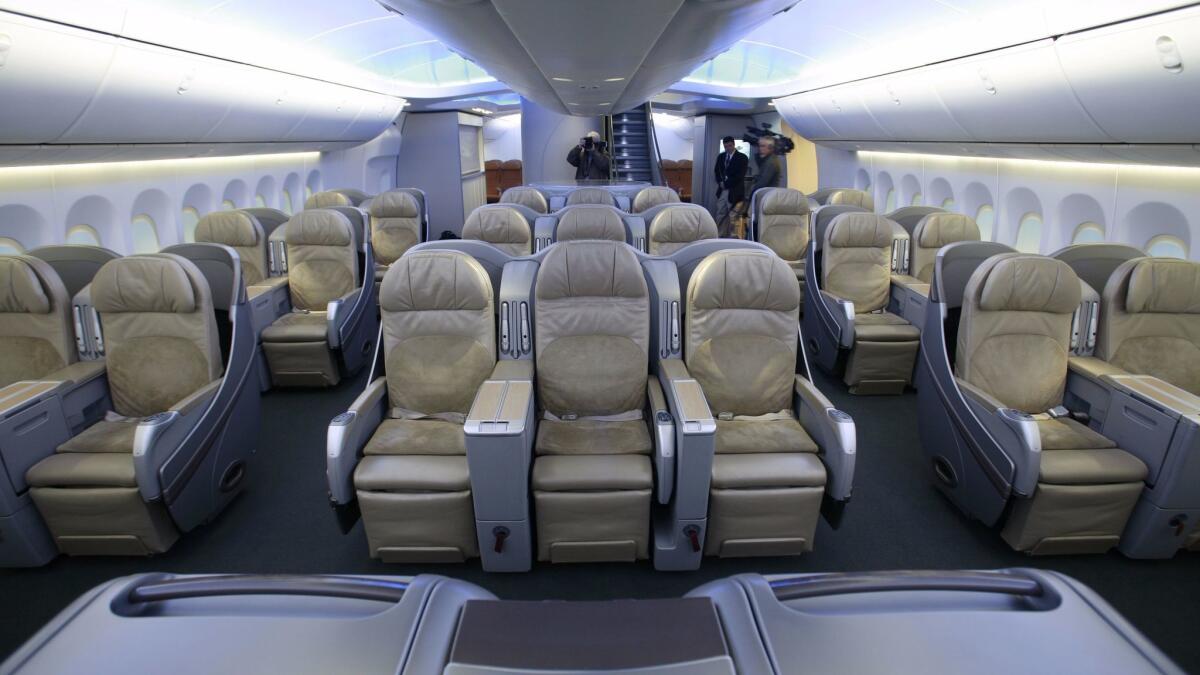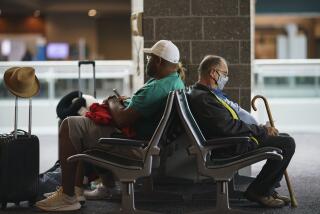You may feel lousy after you get off a long flight. Here’s why and what you can do about it

- Share via
Are you imagining that “hit in the head with a baseball bat” feeling after a flight? If you are, so are thousands of others.
Here’s the best thing you can do: Have a drink. Actually, have several.
We speak here, alas, not of the finest single-malt Scotch but of water.
I became acutely aware of this on a recent five-day, seven-flight sojourn that took me to eastern Canada and five Western states. The overly ambitious itinerary was partly to blame, but mostly the fault was my own.
I had made several through-the-airport dashes to make flights (apparently, I’m no Carl Lewis because I missed several connections) and arrived at the gates hot and sweaty.
Then I got on the plane and the first thing I wanted was a nap, fatigue being a symptom of dehydration. But what I really needed was a drink of water.
“With changes in pressurization in the cabin, you do dehydrate; you lose fluids more quickly,” said Dr. Diana Kerwin, chief of geriatrics, Texas Health Dallas and founder of Texas Alzheimer’s and Memory Disorders.
Don’t think of it as an airplane, Kerwin said. Think of it as a flying desert.
Besides sleepiness, lack of fluid can make you confused or dizzy. Your head may throb.
These are warning signals that your body needs attention. Right now.
Consider too that those of us who live in this area generally are flatlanders. But a plane often is pressurized to about 8,000 feet, so it’s like spending time in Denver plus a couple thousand feet. (Some newer aircraft are pressurized even lower, which may make your life a little easier, but it’s still a change for the Beach Blanket Bingo state.)
If you take, say, a diuretic, you may be tempted to cut back because you don’t want to be getting up and down during a flight.
Resist that temptation. You could injure your kidneys, Kerwin said.
If you’re worried about making it to the restroom, don’t wait until you have to go, she said. If it’s safe to get up, go ahead and go. Think of it as a sort of preventive peeing.
Both Kerwin and Dr. Joseph Austin, a pulmonologist at Texas Health Arlington Memorial, encourage fliers to get up and walk if they can do so safely.
It helps shake off the cobwebs a bit, but it also helps prevent blood clots.
If you can’t get up, do some ankle twirls and other stretches. Many airlines have suggested seat exercises printed on the safety information card. The incentive to do so: Movement helps. Blood clots, both doctors noted, can be fatal.
Austin further recommends taking a baby aspirin before a flight, unless there’s a medical reason not to do so.
And remember that the air is extremely dry, so you might consider packing a saline nasal spray (but less than 3 ounces to comply with liquid carry-on regulations).
Also limit your intake of salty foods, Austin said.
Finally, if you’re feeling a little bit of first-class envy on that long transatlantic or transpacific flight, consider that you may be doing your health a favor by not lying flat.
“You’re not as well ventilated when you’re lying flat as when you are sitting upright,” Austin said. To optimize ventilation, lean forward slightly.
Those folks in the upper classes may be more comfortable in the short term, but you’ll be breathing easier, figuratively and perhaps literally.
And remember, when the drink cart comes around, ask the flight attendant to make yours a double … cup of water.
To read this article in Spanish, click here.
ALSO
Keeping yourself safe from that dreaded (and dreadful) ‘stomach flu’ at sea
10 places to find a little peace and quiet in Paris
U.S. summer vacation spending to top $100-billion mark, up 13% over last year, survey finds
More to Read
Sign up for The Wild
We’ll help you find the best places to hike, bike and run, as well as the perfect silent spots for meditation and yoga.
You may occasionally receive promotional content from the Los Angeles Times.







